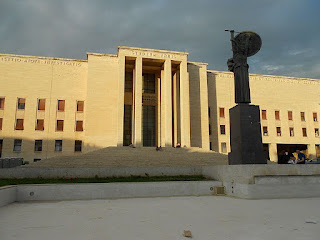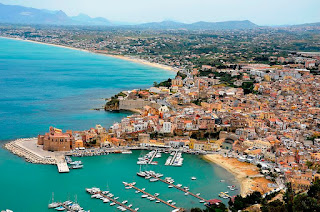When Italians celebrate First World War victory as well as their unification
.jpg) |
| Sergio Mattarella, the Italian President, pictured in 2022 paying his respects at the Tomb of the Unknown Solider |
The fourth day of November has been an Italian National Day since 1919, established to commemorate the country’s victory in World War I. This event was also considered to be the completion of the process of the Unification of Italy, finally ending Austrian occupation of the northern part of the country, which made it an even more important date in Italian history.
In Rome, the President of Italy and other important officers of the State, pay homage to the Italian unknown soldier, milite ignoto, buried in the Altare della Patria in the centre of the capital.
Close to this day they also visit the Redipuglia War Memorial in Friuli-Venezia Giulia, where the remains of 100,000 soldiers who died during World War I are buried, and the small town of Vittorio Veneto in the Veneto, which was the site of the last decisive battle between the Royal Italian Army and the Austro-Hungarian Army.
The President and his colleagues send a message of gratitude, on behalf of the whole country, to the Italian Armed Forces on this day, and celebrations also take place in individual comuni, provinces, and regions throughout Italy.
When the change of the guards happens on November 4 at Rome's Palazzo del Quirinale, the presidential palace, the 4th Carabinieri cavalry regiment wear high uniform, which happens on only two other occasions during the year.
Army and navy barracks throughout Italy are open to the public to visit, there are concerts by military bands, and commemoration ceremonies take place in front of the monument to the fallen in each individual comune.
Quattro Novembre is the only Italian national day that has lasted throughout decades of Italian history, through the years of the Kingdom of Italy, the Fascist period, and the republican era.
In 1922, after the March on Rome that resulted in the Fascists coming into power in Italy, the name of the day was changed to Anniversario della Vittoria - Victory Day - to emphasise Italy’s military power.
But in 1949, after the end of World War II, the original name was restored to celebrate the country’s armed forces and national unity.
 |
| The Redipuglia War Memorial in Friuli-Venezia Giulia is another site of commemoration on November 4 |
In 1946, after the birth of the Republic, the national anthem was changed from the Marcia Reale, brought in before Italian unification by the Savoy family in 1831, to il canto degli italiani.
This is better known by Italians as L’inno di Mameli, or Fratelli d’Italia, and is recognised by sports fans all over the world because it is played before matches involving the Italian national team.
Goffredo Mameli, who was a fervent patriot, wrote the text for the anthem in 1847 and it was set to music by the composer Michele Novaro.
This was officially played as the Italian national anthem for the first time on the occasion of the National Unity and Armed Forces day on November 4, 1946.
Il Giorno dell’Unità Nazionale remained a public holiday until 1976, but then the calendar of public holidays was reformed because of austerity in Italy and it became a moveable feast, to be celebrated on the first Sunday of November.
But thanks to former president Carlo Ciampi, who worked to encourage Italians to value their symbols and traditions, the holiday has been celebrated more widely this century, although November 4 is now a national day in the Italian calendar, rather than a public holiday, so that it does not affect the working life of the population.
This year, 2025, for the third consecutive year, Italy marks the annual day by opening state-run museums and archaeological sites free of charge.
 |
| The Altare della Patria is part of the Monument to Vittorio Emanuele II, the first king of Italy |
The foundation stone of the Altare della Patria - originally designed to commemorate King Vittorio Emanuele II of Savoy - was laid in 1885 in the presence of his son and successor Umberto I and his family. The monument, officially opened in 1911 on the 50th anniversary of the Unification of Italy, occupies a site on the northern slope of the Capitoline (Campidoglio) Hill, a few steps from the ruins of the Forum, the heart of ancient Rome. Built in white Botticino marble, the multi-tiered monument is 135m (443 ft) wide, 130m (427 ft) deep, and 70m (230 ft) high, rising to 81m (266ft) including the two statues of a chariot-mounted winged goddess Victoria on the summit of the two propylaea. The Altare della Patria is actually just one part of the monument, at the front and in the centre, consisting of an inset statue of the goddess Roma and the Tomb of the Unknown Soldier, where two soldiers guard an eternal flame. Above it is a large bronze horse-back statue of Vittorio Emanuele II himself on a central plinth in front of the broad upper colonnade. A national symbol of Italy, the monument has an important ceremonial role. On three occasions each year - on Liberation Day (April 25), Republic Day (June 2) and Armed Forces Day (November 4) - the President of the Republic lays a laurel wreath at the Tomb of the Unknown Soldier to honour those who sacrificed their lives in the service of the country.
Book a hotel in Rome with Expedia
.jpg) |
| Piazza Flaminio shows off the Renaissance charm of the Serravalle section of Vittorio Veneto |
Vittorio Veneto is a picturesque town in the province of Treviso north of Venice. It was formed in 1866 by the merging of two towns - Serravalle. Ceneda, with Roman and ecclesiastical roots, and Serravalle, known for its medieval architecture and mercantile past. The name honours Vittorio Emanuele II, Italy’s first king, and the region of Veneto. The town became well known for its proximity to the decisive moment of Italy’s World War One campaign, the Battle of Vittorio Veneto in October-November 1918, when Italian forces under the command of General Armando Diaz defeated the Austro-Hungarian army. The victory is commemorated in museums and monuments throughout the town. The districts of Ceneda and Serravalle retain distinct identities, linked by the elegant Viale della Vittoria. Visitors are drawn to its cultural heritage, wine traditions, and proximity to Venice and the Dolomites. The 15th century buildings surrounding Serravalle’s Piazza Flaminio were used by the director Franco Zeffirelli to represent the city of Verona in his adaptation of Shakespeare's play, Romeo and Juliet, a film known for its authentic Italian Renaissance atmosphere.
Stay in Vittorio Veneto with Hotels.com
More reading:
Armado Diaz, the Neapolitan general who led decisive victory over Austria-Hungary
The history of the Vittorio Emanuele II Monument
Also on this day:
1333: Florence devastated as River Arno floods
1448: The birth of Alfonso II, King of Naples
1575: The birth of Baroque painter Guido Reni
1737: The inauguration of Teatro di San Carlo in Naples
1964: The birth of crime writer Sandrone Dazieri
.jpg)



.jpg)
.jpg)





.jpg)










